 |
 |
 |
 |
 |
 |
| |
 |
|
 |
 |
 |
  |
  |
 |
 |
 |
 |
| PREMIO PRITZKER 2010 | KAZUYO SEJIMA, RYUE NISHIZAWA
|
|
29 marzo 2010
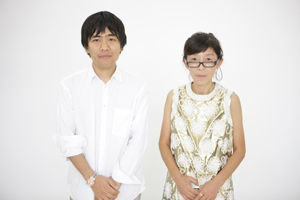 Kazuyo Sejima e Ryue Nishizawa, partner dello studio di architettura SANAA, sono stati scelti come vincitori del Premio Pritzker di architettura 2010. La cerimonia ufficiale di consegna di quello che viene riconosciuto in tutto il mondo come il più alto riconoscimento nel campo dell'architettura si terrà il 17 maggio nella storica Ellis Island, a New York. In quell'occasione verranno consegnati ai due architetti il premio di 100.000 dollari e la medaglia in bronzo. Kazuyo Sejima e Ryue Nishizawa, partner dello studio di architettura SANAA, sono stati scelti come vincitori del Premio Pritzker di architettura 2010. La cerimonia ufficiale di consegna di quello che viene riconosciuto in tutto il mondo come il più alto riconoscimento nel campo dell'architettura si terrà il 17 maggio nella storica Ellis Island, a New York. In quell'occasione verranno consegnati ai due architetti il premio di 100.000 dollari e la medaglia in bronzo.
Annunciando la scelta della giuria, Thomas J. Pritzker, presidente della Fondazione Hyatt, si è così espresso: "E' la terza volta nella storia di questo riconoscimento che due architetti vengono premiati nello stesso anno. La prima fu nel 1988, quando furono premiati il brasiliano Oscar Niemeyer e lo scomparso Gordon Bunshaft; la seconda è stata nel 2001, quando furono selezionati Jacques Herzog e Pierre de Meuron, partner del loro studio in Svizzera".
Ha continuato: "Altre tre volte, nella storia trentennale del Premio di Architettura Pritzker, sono stati scelti architetti giapponesi. La prima è stata nel 1987 con lo scomparso Kenzo Tange, poi, nel 1993, fu selezionato Fumihiko Maki, e, nel 1995, è stato premiato Tadao Ando."
Lo scopo del Premio di Architettura Pritzker è quello di premiare, ogni anno, un architetto vivente le cui opere mostrano una combinazione di talento, visione ed impegno tali da produrre un contributo significativo per l'umanità e per l'ambiente, espresso attraverso l'arte dell'architettura.
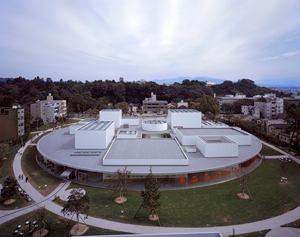 Lord Palumbo, presidente della giuria del premio Pritzker, ha sottolineato con quali motivazioni la giuria sia arrivata alle scelte di quest'anno: "Per un'architettura che è allo stesso tempo delicata e potente, precisa e fluida, geniale ma non eccessiva o esibizionista; per la realizzazione di edifici che interagiscono nel migliore dei modi con i loro contesti e con le attività che contengono, creando un senso di appagamento ed un arricchimento di esperienza; per un linguaggio architettonico singolare che nasce da un processo di collaborazione che è al tempo stesso unico ed ispirato; per gli edifici notevoli che hanno realizzato e per i nuovi progetti insieme che faranno, Kazuyo Sejima e Ryue Nishizawa sono i destinatari del Premio Pritzker di Architettura 2010". Lord Palumbo, presidente della giuria del premio Pritzker, ha sottolineato con quali motivazioni la giuria sia arrivata alle scelte di quest'anno: "Per un'architettura che è allo stesso tempo delicata e potente, precisa e fluida, geniale ma non eccessiva o esibizionista; per la realizzazione di edifici che interagiscono nel migliore dei modi con i loro contesti e con le attività che contengono, creando un senso di appagamento ed un arricchimento di esperienza; per un linguaggio architettonico singolare che nasce da un processo di collaborazione che è al tempo stesso unico ed ispirato; per gli edifici notevoli che hanno realizzato e per i nuovi progetti insieme che faranno, Kazuyo Sejima e Ryue Nishizawa sono i destinatari del Premio Pritzker di Architettura 2010".
Anche se la maggior parte del loro lavoro è in Giappone, Sejima e Nishizawa hanno realizzato progetti in Germania, Inghilterra, Spagna, Francia, Paesi Bassi e Stati Uniti, sotto la firma di SANAA, che li comprende entrambi. Il primo progetto di SANAA negli Stati Uniti iniziò ad essere costruito nel 2004 in Ohio, un padiglione di vetro per il Toledo Museum of Art. Completato nel 2006, ospita la vasta collezione di opere d'arte in vetro del museo, che rappresenta la storia della città quando essa era un importante centro di produzione di vetro.
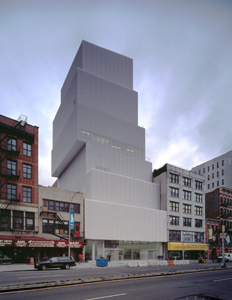 Nel 2005, mentre questo edificio era ancora in costruzione, iniziavano i lavori per il New Museum di New York, a 235 Bowery. Completato nel 2007, l'edificio è stato descritto come "una pila scultorea di scatole squadrate dinamicamente disassate intorno a un nucleo centrale in acciaio." Nel 2005, mentre questo edificio era ancora in costruzione, iniziavano i lavori per il New Museum di New York, a 235 Bowery. Completato nel 2007, l'edificio è stato descritto come "una pila scultorea di scatole squadrate dinamicamente disassate intorno a un nucleo centrale in acciaio."
La citazione della giuria cita espressamente questi due progetti, oltre a due progetti in Giappone: "L'O-Museum a Nagano e il 21st Century Museum of Contemporarry Art di Kanazawa." Il Museo Ogasawara è stato uno dei loro primi progetti insieme.
Il teatro e centro culturale De Kunstline ad Almere, Paesi Bassi, ed il più recente Rolex Learning Center di Losanna, in Svizzera, sono altri dei maggiori progetti di SANAA. Altre opere notevoli in Giappone sono il terminal dei traghetti di Naoshima ed il palazzo per Christian Dior a Tokyo.
A Essen, in Germania, nel 2006 è stata inaugurata la Scuola di Management e Progettazione Zollverein in un nuovo edificio progettato da SANAA su una vecchia miniera di carbone. L'edificio è come un cubo di grandi dimensioni (circa 35 metri per ogni lato), con una disposizione insolita delle aperture e delle finestre, di quattro diverse misure.
Il Padiglione Serpentine Gallery a Londra (nono della serie di Padiglioni Serpentine), il loro primo progetto realizzato nel Regno Unito, per tre mesi è stato sul prato della galleria. In Francia, una filiale del Museo del Louvre a Lens, sarà un'edificio di quasi 30.000 metri quadrati.
A Valencia, in Spagna, SANAA ha progettato un ampliamento per l'IVAM (Istituto Valenciano di Arte Moderna), nel quale il loro edificio che ospita le otto gallerie esistenti sarà completamente chiuso da una pelle traslucida che copre un intero isolato, oltre alla creazione di nuovi spazi pubblici interni/esterni tra l'edificio e la pelle. Il rivestimento ideato è un metallo leggero perforato che permette a luce, vento e pioggia di passargli attraverso. La costruzione non è ancora iniziata.
Entrambi gli architetti hanno anche un ottimo curriculum comprendente opere realizzate personalmente.
Quando ha saputo che stava per essere premiata, Kazuyo Sejima ha così commentato: "Sono entusiasta di ricevere un tale onore. Vorrei ringraziare la Fondazione Pritzker (Hyatt), i componenti della giuria, i clienti che hanno lavorato con noi, e tutti i nostri collaboratori. Ho esplorato come poter fare architettura che sembri aperta, che mi sembra importante per una nuova generazione dell'architettura. Con questo premio voglio continuare a cercare di fare architettura meravigliosa. "
E una reazione simile è stata espressa anche da Ryue Nishizawa: "Ho ricevuto questo bellissimo premio con grande umiltà. Sono molto onorato e al tempo stesso molto sorpreso. Prendo questo premio come un incoraggiamento per i nostri sforzi. Ogni volta che finisco un edificio mi compiaccio per quanto realizzato e, allo stesso tempo, rifletto su quanto è accaduto. Ogni progetto diventa una motivazione per quello successivo. Nello stesso modo questo meraviglioso premio mi ha dato una carica dinamica che non ho mai provato prima. Vi ringrazio molto."
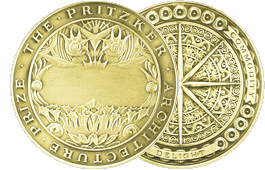 La giuria selezionata che ha scelto i vincitori del Premio 2010 era composta dal suo Presidente, Lord Palumbo, internazionalmente conosciuto come mecenate dell'architettura di Londra, presidente di fondazioni, Serpentine Gallery, ex presidente del Consiglio delle Arti della Gran Bretagna, ex presidente della Tate Gallery Foundation, ex fiduciario dell'Archivio Mies van der Rohe al Museum of Modern Art, e, in ordine alfabetico: Alejandro Aravena, architetto e direttore esecutivo di Elemental, Santiago del Cile; Rolf Fehlbaum, presidente del consiglio d'amministrazione della Vitra, Basilea, Svizzera; Carlos Jimenez, professore, Rice University School of Architecture, responsabile del Carlos Jimenez Studio a Houston, Texas; Juhani Pallasmaa, architetto, professore ed autore di Helsinki, Finlandia; Renzo Piano, architetto e vincitore del Premio pritzker, con studi a Parigi, Francia e Genova, Italia; e Karen Stein scrittore, curatore e consulente di architettura in New York. Martha Thorne, decano associato per le relazioni esterne, IE Scuola di Architettura di Madrid, Spagna, che è il direttore esecutivo del premio ha ulteriormente aggiunto, citando la giuria: "L'architettura di Sejima e Nishizawa esplora i concetti di leggerezza e trasparenza e spinge i confini di questi concetti verso nuovi orizzonti". La giuria selezionata che ha scelto i vincitori del Premio 2010 era composta dal suo Presidente, Lord Palumbo, internazionalmente conosciuto come mecenate dell'architettura di Londra, presidente di fondazioni, Serpentine Gallery, ex presidente del Consiglio delle Arti della Gran Bretagna, ex presidente della Tate Gallery Foundation, ex fiduciario dell'Archivio Mies van der Rohe al Museum of Modern Art, e, in ordine alfabetico: Alejandro Aravena, architetto e direttore esecutivo di Elemental, Santiago del Cile; Rolf Fehlbaum, presidente del consiglio d'amministrazione della Vitra, Basilea, Svizzera; Carlos Jimenez, professore, Rice University School of Architecture, responsabile del Carlos Jimenez Studio a Houston, Texas; Juhani Pallasmaa, architetto, professore ed autore di Helsinki, Finlandia; Renzo Piano, architetto e vincitore del Premio pritzker, con studi a Parigi, Francia e Genova, Italia; e Karen Stein scrittore, curatore e consulente di architettura in New York. Martha Thorne, decano associato per le relazioni esterne, IE Scuola di Architettura di Madrid, Spagna, che è il direttore esecutivo del premio ha ulteriormente aggiunto, citando la giuria: "L'architettura di Sejima e Nishizawa esplora i concetti di leggerezza e trasparenza e spinge i confini di questi concetti verso nuovi orizzonti".
Oltre ai precedenti vincitori già menzionati, il primo vincitore del Pritzker, nel 1979, fu Philip Johnson. Luis Barragán, Messico, fu premiato nel 1980. Il britannico James Stirling fu premiato nel 1981, Kevin Roche nel 1982, Ieoh Ming Pei nel 1983, e Richard Meier nel 1984. Hans Hollein, Austria, vinse nel 1985. Il tedesco Gottfried Böhm ha ricevuto il premio nel 1986. Robert Venturi ha ricevuto il premio nel 1991, ed il portoghese Alvaro Siza nel 1992. Christian de Portzampar, Francia vinse il premio Pritzker nel 1994. Frank Gehry, Stati Uniti, fu premiato nel 1989, Aldo Rossi, Italia, nel 1990. Nel 1996 fu premiato lo spagnolo Rafael Moneo; nel 1997, Sverre Fehn, Norvegia; nel 1998 Renzo Piano, Italia, nel 1999 Sir Norman Foster, Gran Bretagna , e nel 2000, Rem Koolhaas, Paesi Bassi. L'australiano Glenn Murcutt ha ricevuto il premio nel 2002. Il danese Jørn Utzon fu premiato nel 2003; Zaha Hadid, Gran Bretagna, nel 2004 e Thom Mayne, Stati Uniti, nel 2005. Paulo Mendes da Rocha, Brasile, fu premiato nel 2006, e Richard Rogers ha ricevuto il premio nel 2007. Jean Nouvel, Francia, nel 2008 e lo svizzero Peter Zumthor fu premiato lo scorso anno.
Il campo dell'architettura è stato scelto dalla famiglia Pritzker per il loro interesse nel settore delle costruzioni dovuto alla gestione degli Hyatt Hotels in tutto il mondo, ed anche perché l'architettura è un settore creativo non incluso fra i premi Nobel. Le procedure furono modellate proprio sull'esempio del Nobel, con la selezione finale effettuata dalla giuria internazionale dopo deliberazioni e votazioni segrete. Le candidature continuano di anno in anno con centinaia di candidati da paesi di tutto il mondo.
Citation from the Jury
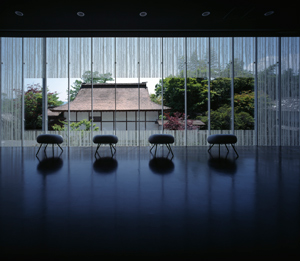 For more than 15 years, architects Kazuyo Sejima and Ryue Nishizawa have worked together in their collaborative part- nership, SANAA, where it is virtually impossible to untangle which individual is responsible for what aspect of a particular project. Each building is ultimately a work that comes from the union of their two minds. Together they have produced major commissions, such as the O-Museum in Nagano and the 21st Century Museum of Contemporary Art in Kanazawa (both in Japan), the Glass Pavilion at the Toledo Museum (Ohio), De Kunstline Theater and Cultural Center (Almere, the Netherlands), the New Museum of Contemporary Art (New York, NY), and the recent Rolex Learning Center (Lausanne, Switzerland). For more than 15 years, architects Kazuyo Sejima and Ryue Nishizawa have worked together in their collaborative part- nership, SANAA, where it is virtually impossible to untangle which individual is responsible for what aspect of a particular project. Each building is ultimately a work that comes from the union of their two minds. Together they have produced major commissions, such as the O-Museum in Nagano and the 21st Century Museum of Contemporary Art in Kanazawa (both in Japan), the Glass Pavilion at the Toledo Museum (Ohio), De Kunstline Theater and Cultural Center (Almere, the Netherlands), the New Museum of Contemporary Art (New York, NY), and the recent Rolex Learning Center (Lausanne, Switzerland).
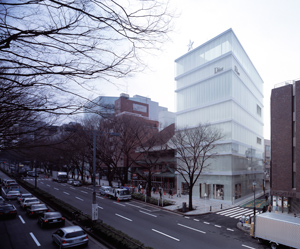 The buildings by Sejima and Nishizawa seem deceptively simple. The architects hold a vision of a building as a seamless whole, where the physical presence retreats and forms a sensuous background for people, objects, activities, and landscapes. They explore like few others the phenomenal properties of continuous space, lightness, transparency, and materiality to create a subtle synthesis. Sejima and Nishizawa’s architecture stands in direct contrast with the bombastic and rhetorical. Instead, they seek the essential qualities of architecture that result in a much-appreciated straightforwardness, economy of means, and restraint in their work. The buildings by Sejima and Nishizawa seem deceptively simple. The architects hold a vision of a building as a seamless whole, where the physical presence retreats and forms a sensuous background for people, objects, activities, and landscapes. They explore like few others the phenomenal properties of continuous space, lightness, transparency, and materiality to create a subtle synthesis. Sejima and Nishizawa’s architecture stands in direct contrast with the bombastic and rhetorical. Instead, they seek the essential qualities of architecture that result in a much-appreciated straightforwardness, economy of means, and restraint in their work.
This economy of means, however, does not become a simple reductive operation in the architects’ hands. Instead, it is an intense and rigorous investigation anchored in hard work and steely determination. It is a constant process of refinement, where each client’s program is fully investigated and multiple design possibilities are explored through numerous drawings and models that check every alternative. Ideas are considered and discarded, reconsidered and reworked until only the essential qualities of a design remain. The result is a deft union of structure and organization, of logical purpose and precise beauty.
It may be tempting to view Sejima and Nishizawa’s refined compositions of lightness and transparency as elitist or rarefied. Their aesthetic, however, is one of inclusion. Their approach is fresh, always offering new possibilities within the normal constraints of an architectural project as it systematically takes the next step. They use common, everyday materials while remaining attuned to the possibilities of contemporary technology; their understanding of space does not reproduce conventional models. 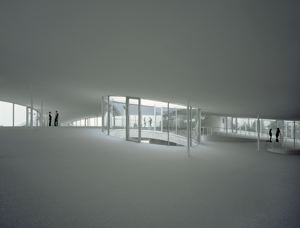 They often opt for non-hierarchical spaces, or in their own words, the “equivalence of spaces,” creating unpretentious, democratic buildings according to the task and budget at hand. One example is the Almere project in the Netherlands, with its many simple classrooms and workshops, all presenting privileged views of the sea. Another example is the Rolex Learning Centre in Lausanne, a space to be used by students day and night. Sejima and Nishizawa originally conceived it as a multi-story building, but, in the course of their deliberation, it became a single yet vast, flowing space. The building’s many spaces (library, restaurant, exhibition areas, offices, etc.) are differentiated not by walls but by undulations of a continuous floor, which rises and falls to accommodate the different uses, while allowing vistas across this internal “land- scape for people.” They often opt for non-hierarchical spaces, or in their own words, the “equivalence of spaces,” creating unpretentious, democratic buildings according to the task and budget at hand. One example is the Almere project in the Netherlands, with its many simple classrooms and workshops, all presenting privileged views of the sea. Another example is the Rolex Learning Centre in Lausanne, a space to be used by students day and night. Sejima and Nishizawa originally conceived it as a multi-story building, but, in the course of their deliberation, it became a single yet vast, flowing space. The building’s many spaces (library, restaurant, exhibition areas, offices, etc.) are differentiated not by walls but by undulations of a continuous floor, which rises and falls to accommodate the different uses, while allowing vistas across this internal “land- scape for people.”
The relation of the building to its context is of utmost importance to Sejima and Nishizawa. They have called public build- ings “mountains in the landscape,” believing that they should never lose the natural and meaningful connection with their surroundings. The New Museum in New York feels at home in the rough Bowery area of the city. Their glass-enclosed museums, such as the Glass Pavilion at the Toledo Museum of Art in Ohio, blur the borders between inside and out, providing direct and changing views to the surroundings.
While Sejima and Nishizawa have not published theoretical treatises to date, they are cerebral architects, whose work is based on rigorous investigation and guided by strong and clearly defined concepts. The appointment of Kazuyo Sejima as the director of the 2010 Venice Architecture Biennale is a tribute to this.
For architecture that is simultaneously delicate and powerful, precise and fluid, ingenious but not overly or overtly clever; for the creation of buildings that successfully interact with their contexts and the activities they contain, creating a sense of fullness and experiential richness; for a singular architectural language that springs from a collaborative process that is both unique and inspirational; for their notable completed buildings and the promise of new projects together, Kazuyo Sejima and Ryue Nishizawa are the recipients of the 2010 Pritzker Architecture Prize.
The Jury
ChairMan
The Lord Palumbo
Architectural Patron, Chairman of the Trustees, Serpentine Gallery
Former Chairman of the Arts Council of Great Britain
Former Chairman of the Tate Gallery Foundation
Former Trustee of the Mies van der Rohe Archive at the Museum of Modern Art, New York
London, England
Alejandro Aravena
Architect and Executive Director of Elemental
Santiago, Chile
Rolf Fehlbaum
Chairman of the Board, Vitra
Basel, Switzerland
Carlos Jimenez
Professor, Rice University School of Architecture
Principal, Carlos Jimenez Studio
Houston, Texas
Juhani Pallasmaa
Architect, Professor and Author
Helsinki, Finland
Renzo Piano
Architect and Pritzker Laureate 1998
Paris, France and Genoa, Italy
Karen Stein
Writer, editor and architectural consultant
New York, New York
Executive Director
Martha Thorne
Associate Dean for External Relations
IE School of Architecture
Madrid, Spain
About some of the major projects of SANAA, works by Kazuyo Sejima and Ryue Nishizawa
 O-Museum O-Museum
Nagano, Japan
The Ogasawara Museum was one of their first projects together, begun in 1995 and completed in 1999. Built on an isolated plateau on the side of a mountain, the site is an important heritage site where a castle from the 14th and 15th centuries once stood. The building’s shape follows the contours of the land, and is raised off the ground to keep the remains of the castle in sight, and also minimizes problems with rising damp from the ground. The entrance is from a square and ramp to a large lobby with a large window that frames the castle remains. Exhibition rooms and service area are in line with the lobby.
 Stadstheater Almere “De Kunstlinie” Stadstheater Almere “De Kunstlinie”
Almere, The Netherlands
In 1998, SANAA was chosen to design a municipal theater and cultural center that would serve both professional and amateur artists. The site is in a town located on a lake just west of Amsterdam. The project is one of many under a master plan developed by OMA. Completed in 2007.
 21st Century Museum of Contemporary Art Kanazawa 21st Century Museum of Contemporary Art Kanazawa
Kanazawa, Ishikawa, Japan
Located in an historic city on the north coast of the Japan, this circular building completely within a glass envelope can be viewed from all angles. There are central exhibition spaces of different proportions surrounded by areas for municipal services such as a library, a workshop for children and a conference room. There is space around the perimeter inside the glass to walk completely around the building. There are four inner courtyards enclosed by glass, and many of the rooms have skylights to provide diffused natural light where needed. This project began in 1999 and was completed in 2004.
 Christian Dior Building, Omotesando Christian Dior Building, Omotesando
Tokyo, Japan
Completed in 2003, the Christian Dior store on Omotesando Avenue in Tokyo called for four retail floors and one multifunctional level. The building could have a maximum height of almost 100 feet so it was decide to achieve the maximum volume and then divide the horizontal spaces of variable heights into retail floors alternated with spaces used for utilities, and all enclosed in glass. Translucent acrylic screens behind the glass can soften the building. At night, the building glows like a jewel in the urban landscape that surrounds it.
 The Toledo Museum of Art Glass Pavilion The Toledo Museum of Art Glass Pavilion
Toledo, Ohio
Begun in 2001 and completed in 2006, this addition to the Toledo Museum of Art was designed to house the museum’s collection of art glass, as well as a laboratory and glass-making foundry for the production of material. The plan, laid out on a single level, is based on a grid of interlocking glass rectangles linking one room to another. The walls of the rooms are of curved glass allowing views to adjacent and/or exterior spaces in various degrees of transparency or translucency. There are interior courtyards as well.
 Zollverein School of Management and Design Zollverein School of Management and Design
Essen, Germany
This project, begun in 2003 and completed in 2006, is located on the site of an old coal mine, near a carbon factory in a suburban area. Designed as a cube, approximately 115 feet to a side, it is a contrast to the large industrial buildings as well as the smaller scale residences around it. Divided into four floors of varying heights, windows of varying dimensions provide natural light and views of the surrounding areas. The first floor is a common study area completely open with no partitions.
 New Museum of Contemporary Art New Museum of Contemporary Art
New York, New York
In the heart of lower Manhattan, this high rise exhibition space increases the amount of wall space and keeps the building within local planning limits by staggering the different levels which makes possible skylights and terraces where the floors overlap. Begun in 2003, the building opened in 2007.
 Rolex Learning Center, EPFL (École Polytechnique Fédérales de Lausanne) Rolex Learning Center, EPFL (École Polytechnique Fédérales de Lausanne)
Lausanne, Switzerland
This project, begun in 2005, is designed to house a library, a center for the study of languages, offices, a cafeteria, restaurant and lobby. The roof and floor have a slightly undulating form. The main entrance can be approached from four sides by walking under the undulating floor slab. There are seven courtyards of varying sizes and shapes. These along with the variations in the space heights and sizes help create different atmospheres for different functions. This project was completed in 2009.
 Naoshima Ferry Terminal Naoshima Ferry Terminal
Naoshima, Kagawa, Japan
Begun in 2003 and completed in 2006, this building is a ferry terminal on a small island in the Inland Sea of Japan. A large (approximately 39,000 square feet) roof covers most of the site, and encompasses several glass enclosed areas that function as visitors center, cafe, event hall, and waiting area, as well as space for parking and bus stops and is described as an entrance hall of the island to accommodate the people together.
Credits
Text and images courtesy by Pritzker Prize/The Hyatt Foundation
Photo of Ryue Nishizawa and Kazuyo Sejima by Takashi Okamoto, Courtesy of SANAA
Photo of 21st Century Museum of Contemporary Art by SANAA, Courtesy of SANAA
Photo of New Museum of Contemporary Art by Hisao Suzuki, Courtesy of SANAA
Photo of O-Museum by Hisao Suzuki, Courtesy of SANAA
Photo of Christian Dior Building by Hisao Suzuki, Courtesy of SANAA
Photo of The Rolex Learning Center by Hisao Suzuki, Courtesy of SANAA

Pritzker Prize |
|
 |
  |
 |
|
|